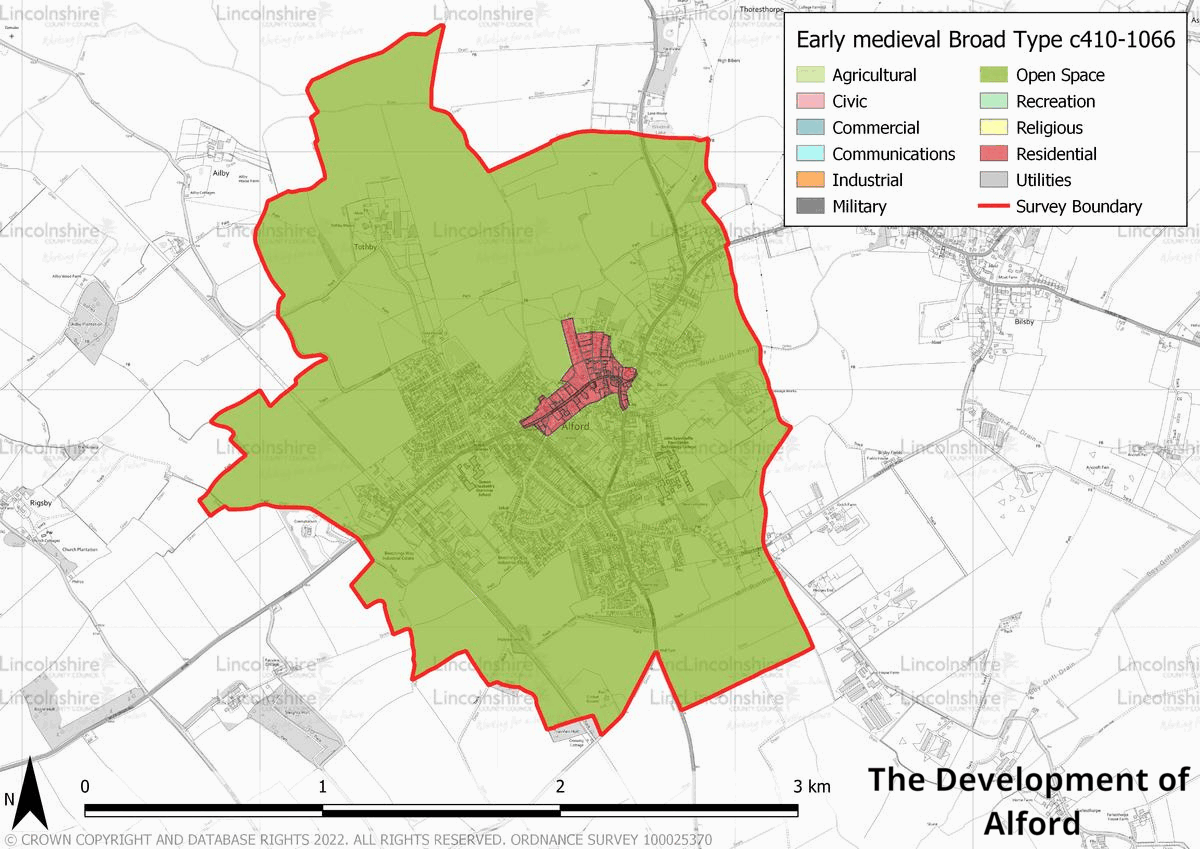ALFORD

Historic Background
There are some archaeological artifacts recorded in the survey area, mainly axes, that indicate some degree of woodland management in the later prehistoric period. There are also two possible Bronze Age barrows recorded in the area. This archaeological evidence, and Alford’s location on the southern end of the probable prehistoric routeway of Barton Street, indicate prehistoric activity in the survey area. Human activity in the Roman period is also suggested by archaeological remains and sporadic finds. The main evidence for this is an enclosure and field system recorded off Tothby Lane, as well as Roman coins found throughout the survey area.
The earliest documentary evidence for Alford can be found in the medieval period through the Domesday Book.
Alford existed prior to 1066 although it was a small village that did not have its own church. No archaeological evidence exists for the settlement at this time because it is likely to have been buried beneath the later medieval settlement. The name ‘Alford’ could have two origins, one meaning ‘alder ford’ or ‘ford by the alder trees’ and the other meaning ‘ford by a heathen temple’. The first recorded church in Alford dated to around 1150 and was located on the same site as the current Church of St Wilfred. The latter was constructed after the demolition of the former in 1350, the work was funded by William of Tothby. Tothby is currently a farmstead but was the location of Tothby Manor and the deserted medieval hamlet of Tothby, both of which seem to have played an important part in Alford’s medieval history. Alford’s medieval core seems to have centred around the church, following West Street, Church Street and South Market Place. A market and a fair were granted to Alford in 1283. The creation of these in the late 13th century coincided with the increasing value of the wool trade at the time. Alford being an agricultural community located between the Wolds and the Marsh benefited as a trading location, another fair was granted in 1439.
In the first half of the post-medieval period wool production was still an important part of the Lincolnshire rural economy, of which Alford was part of. Along West Street there are several 17th and 18th century extant buildings, including Alford Manor House which is currently used as a museum. In the 19th century there were at least four mills in Alford, one of which is still conserved. The arrival of the railway to Alford in 1848 brough trade and industrial growth. This in turn led to population growth and more residential development. When the railway station closed in 1970 its surrounding area was replaced by an industrial estate. Apart from this there is also industry nearer to the town centre, which include a fire-safety equipment supplier and a coal depot. The 20th and 21st centuries have seen residential expansion of the town away from the traditional hugging of the main roads.

Character Summary:
There are several character areas and patterns of development in Alford. HUCA 1 represents the historic core of the town, some probable burgage plots can be identified and the medieval church still stands. However, the majority of the character area consists of post-medieval buildings. Notable are the early post-medieval thatched buildings on West Street. HUCA 2 represents the 19th century residential expansion of the town. The character area broadly follows East Street, West Street and South Street. HUCA 3 consists of 20th and 21st century residential expansion with educational facilities and a cemetery. HUCA 4 is centred around the old railway station, the main building of which is extant but repurposed after its closure in 1970. The character area is mainly industrial in nature, consisting in the Beechings Way industrial estate. HUCA 5 is a predominantly agricultural area with fields and farmsteads throughout. There are also sports fields, utilities and the location of the deserted medieval hamlet of Tothby, as well as the now lost Tothby Manor.



